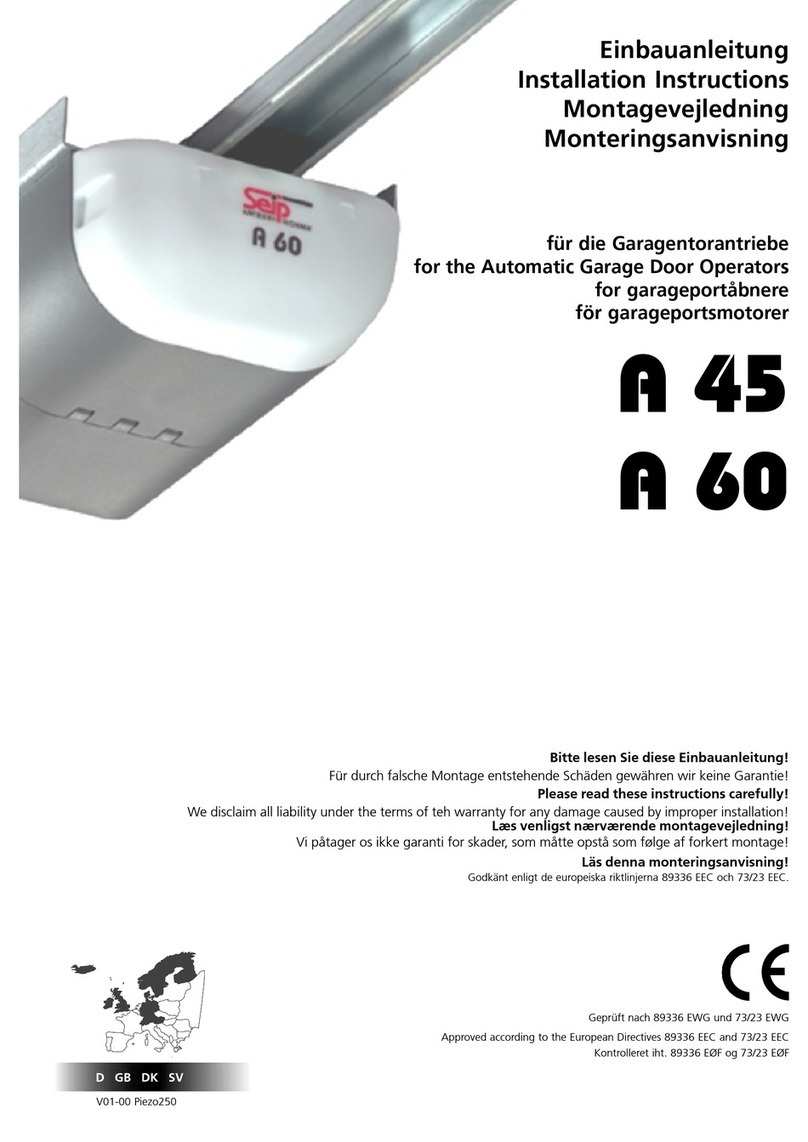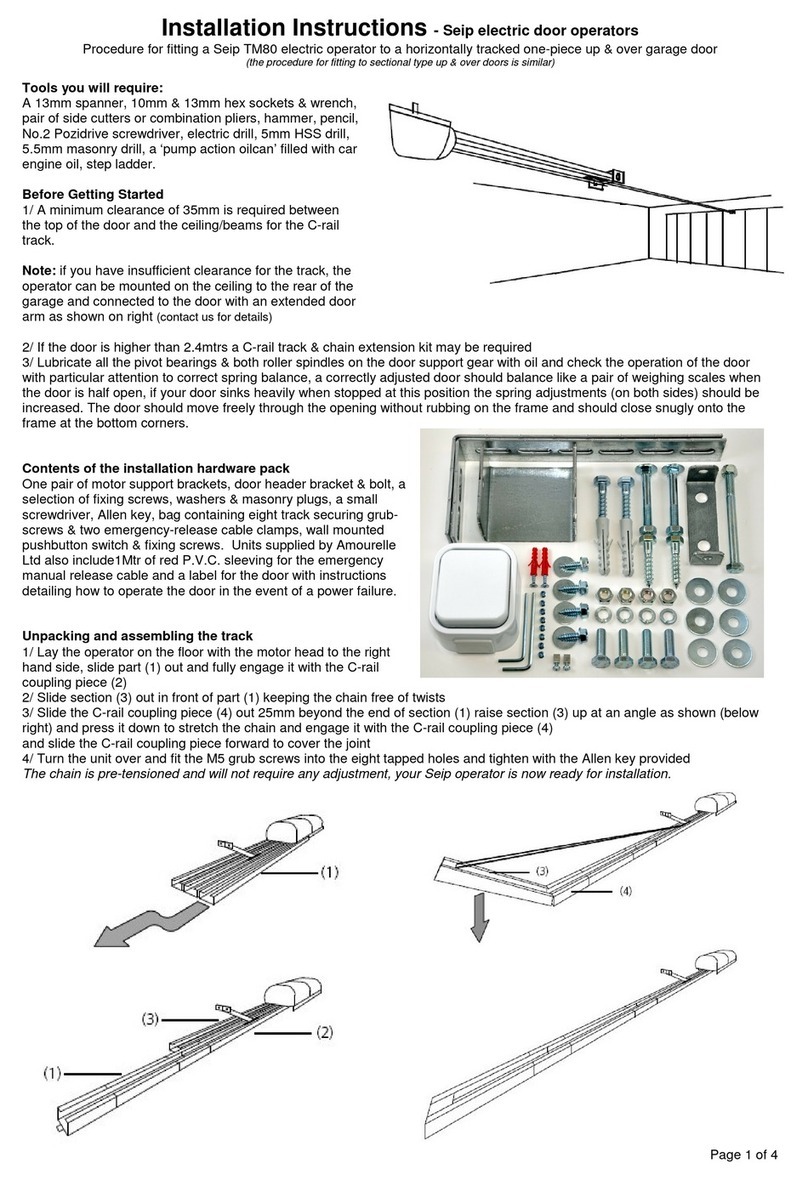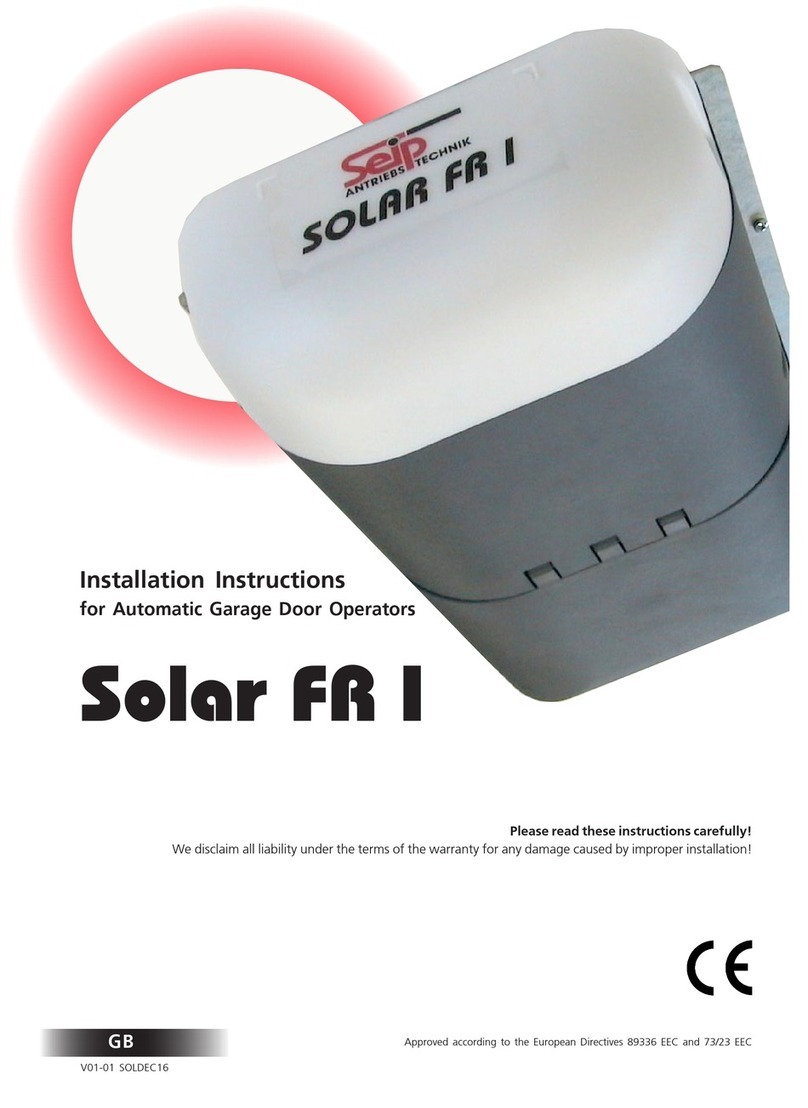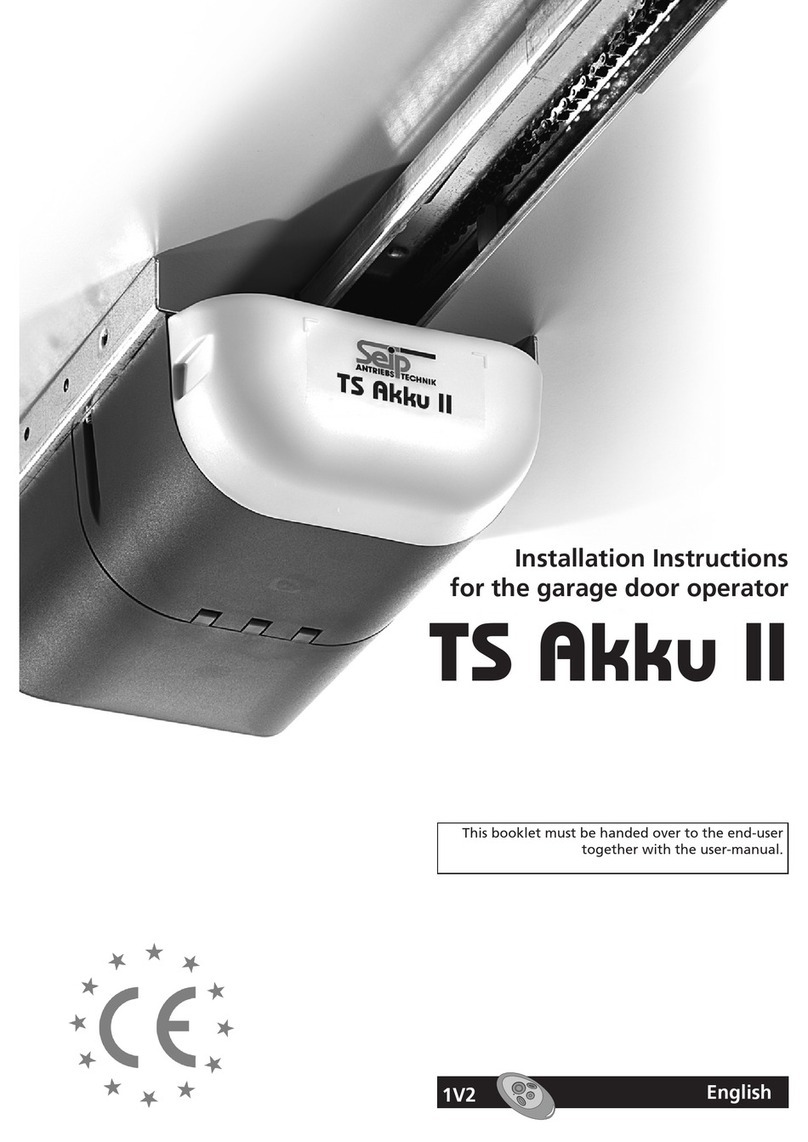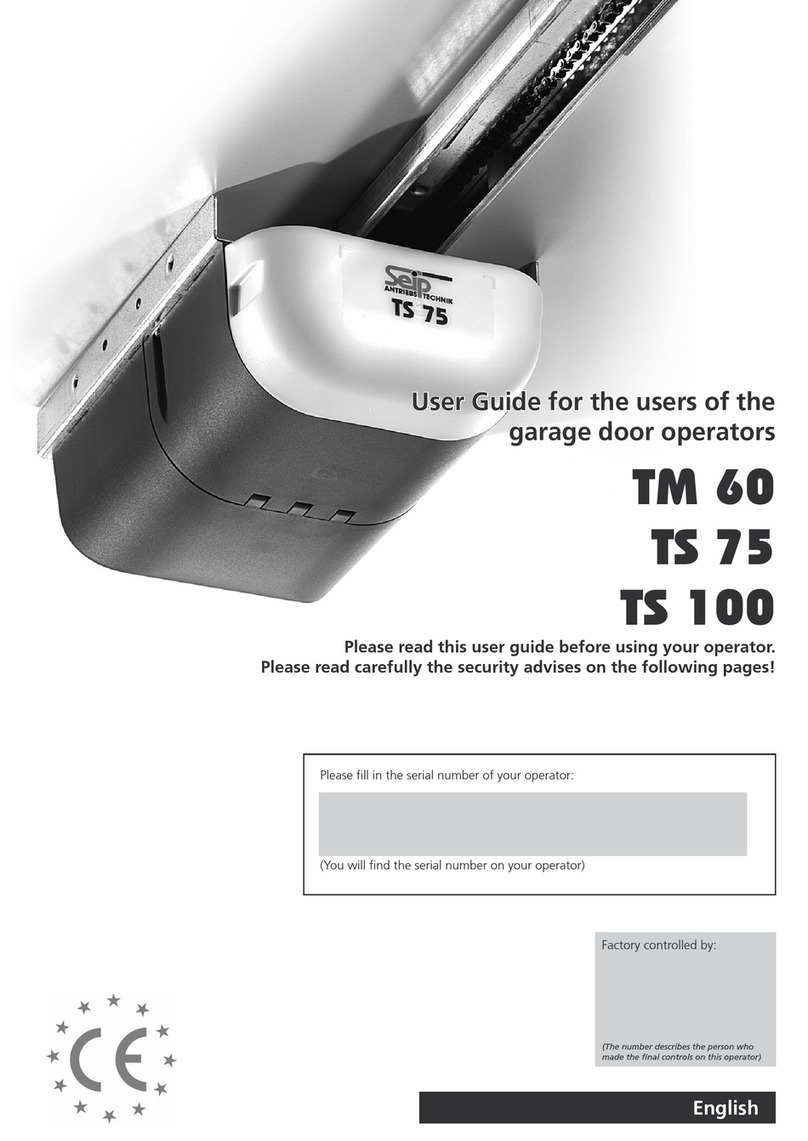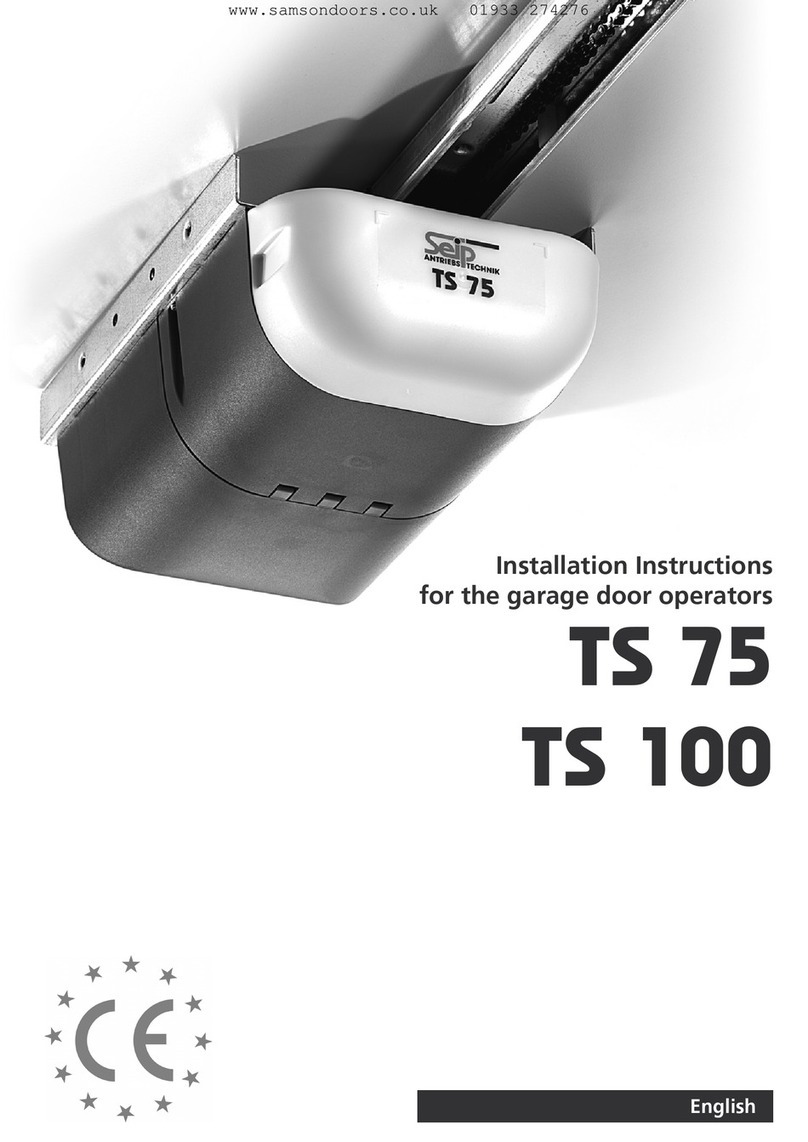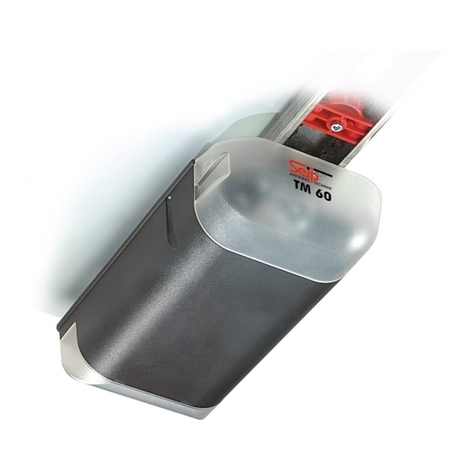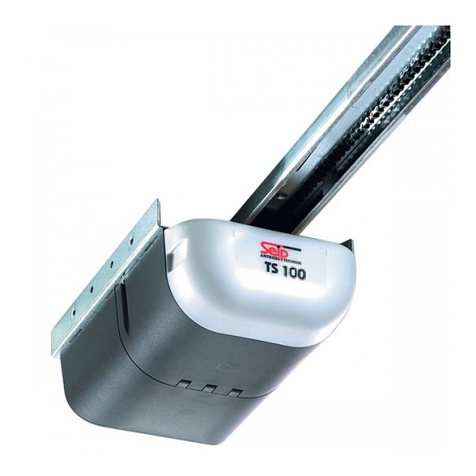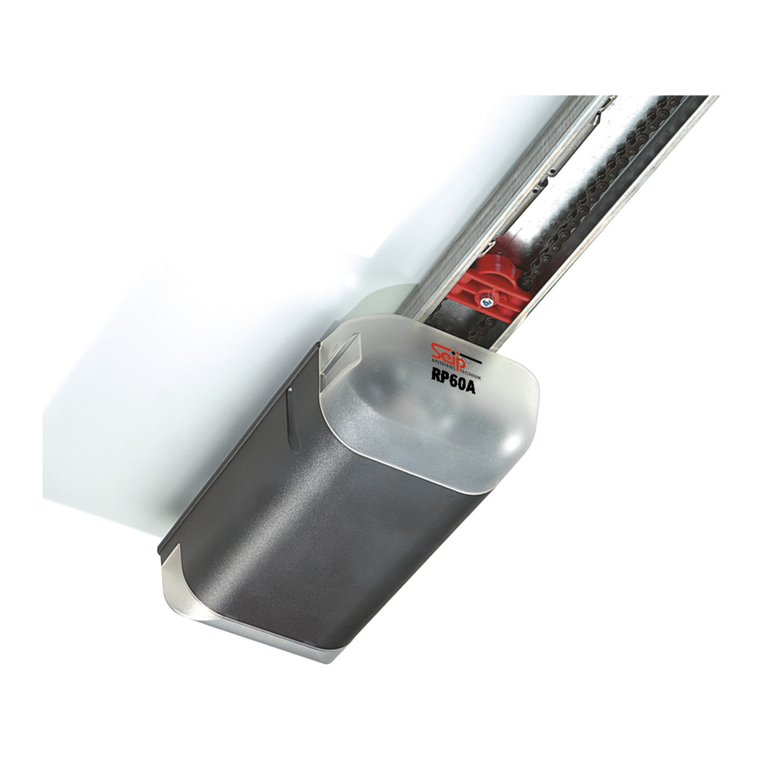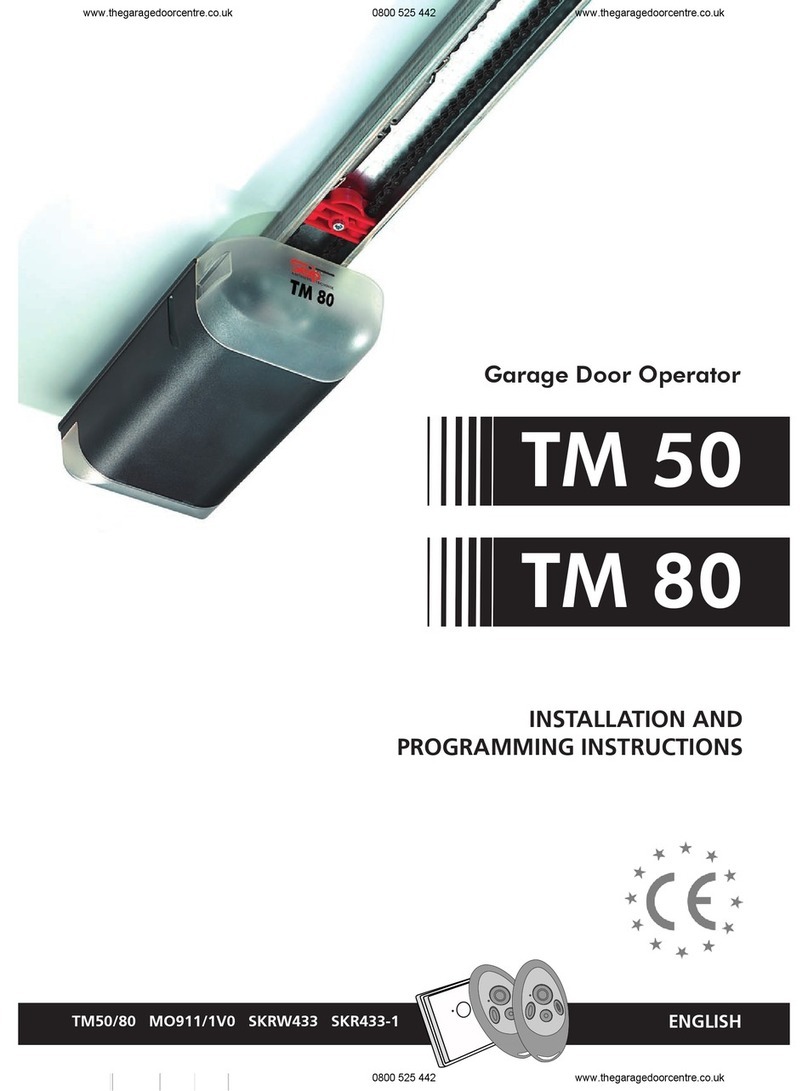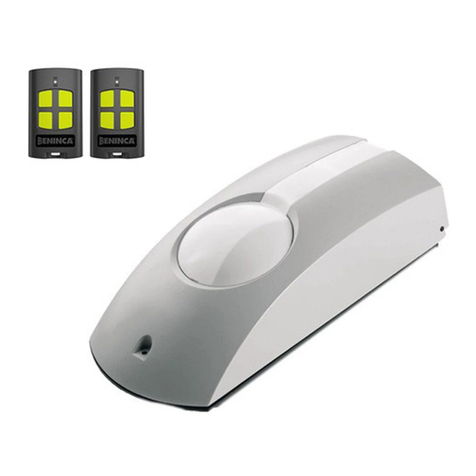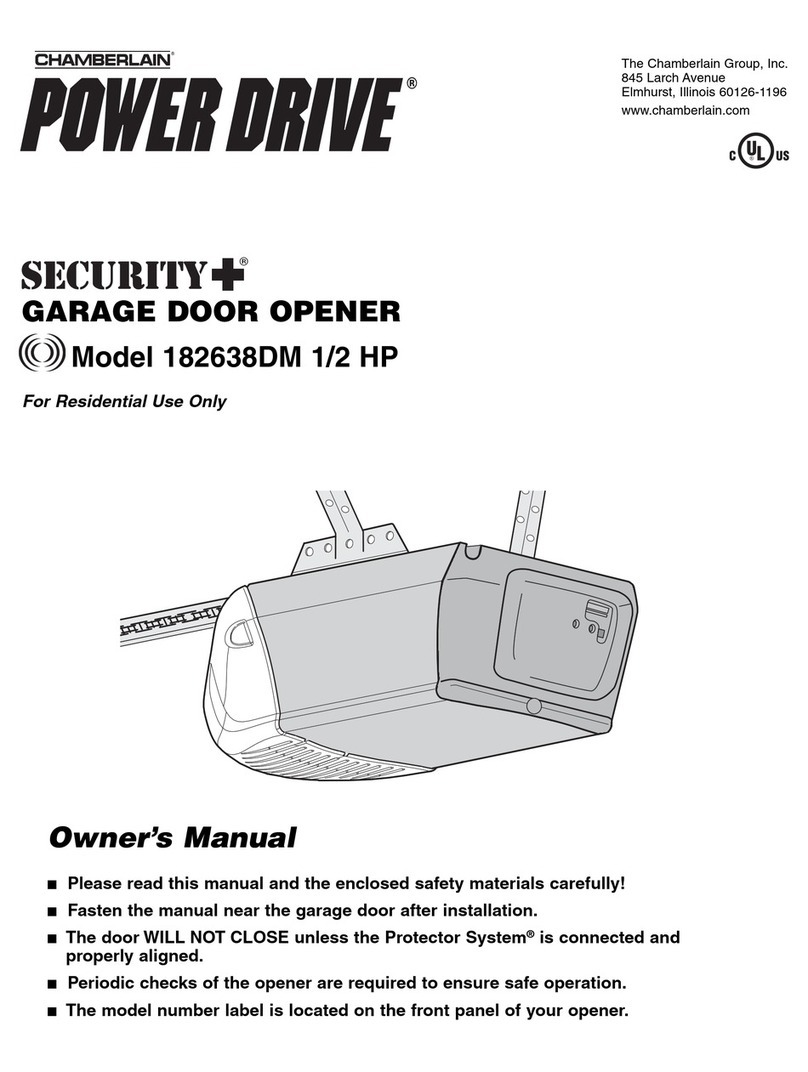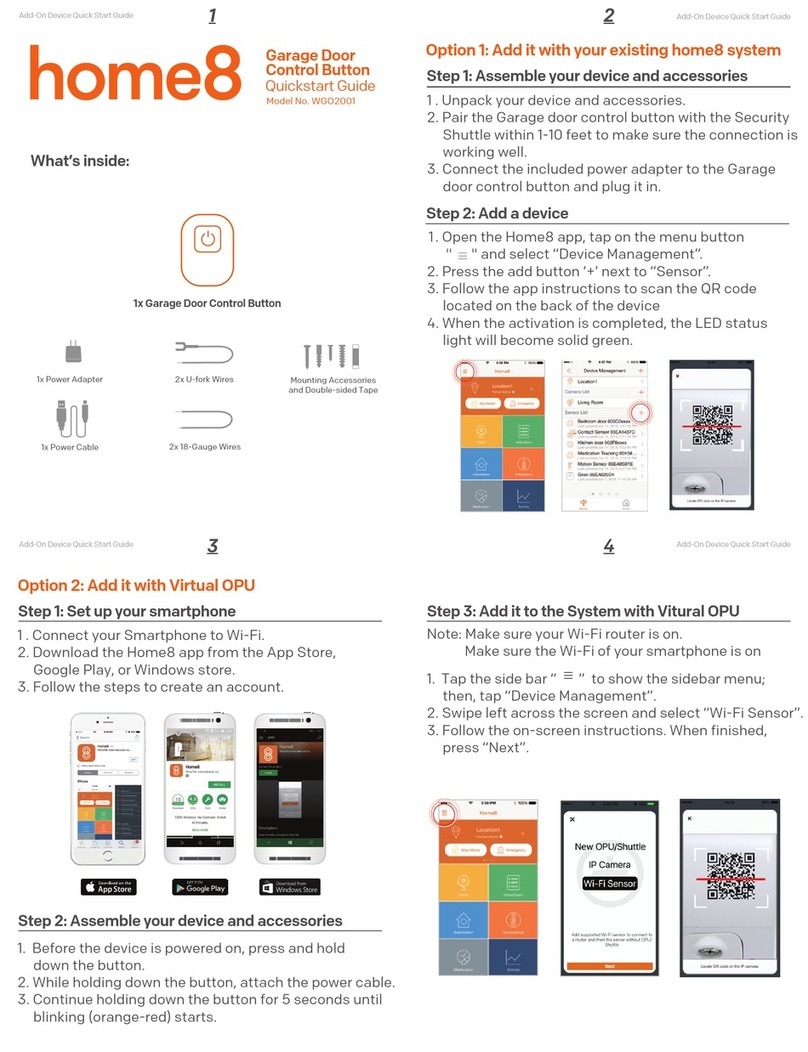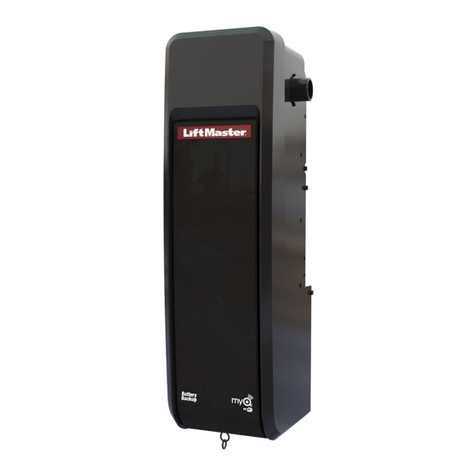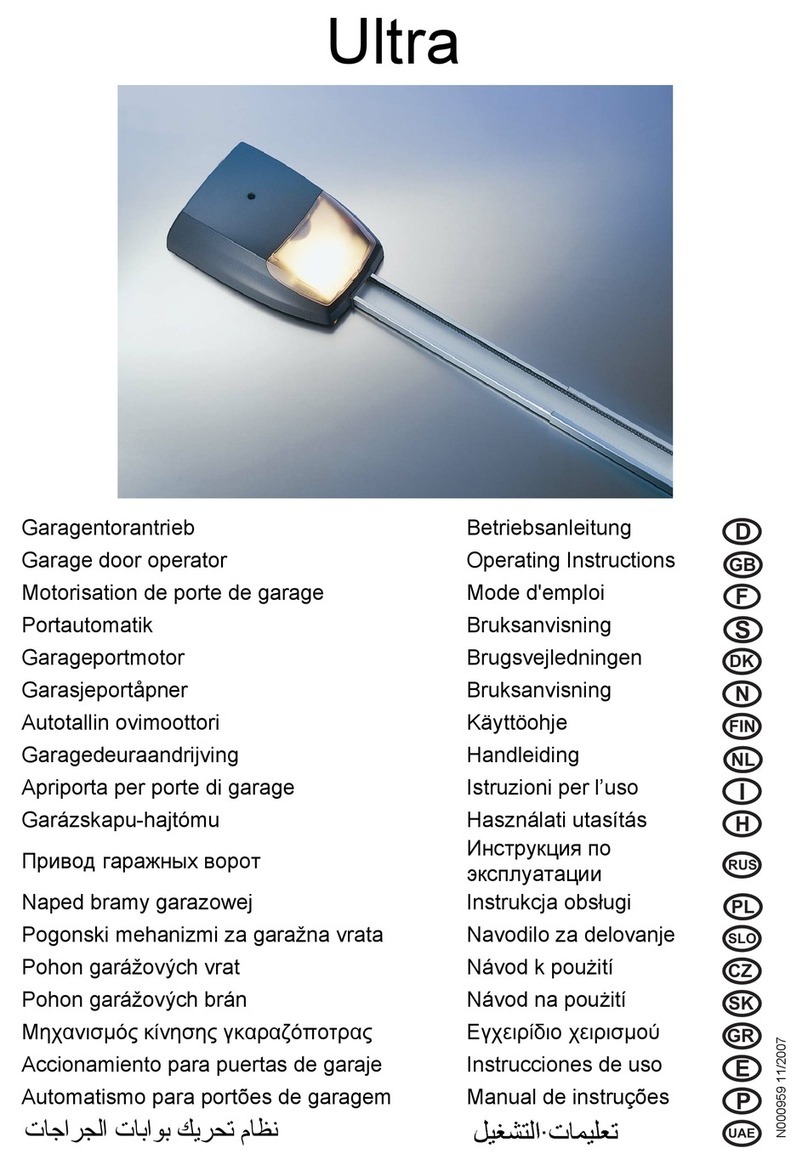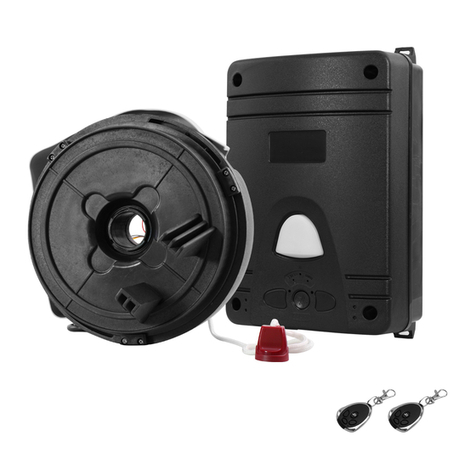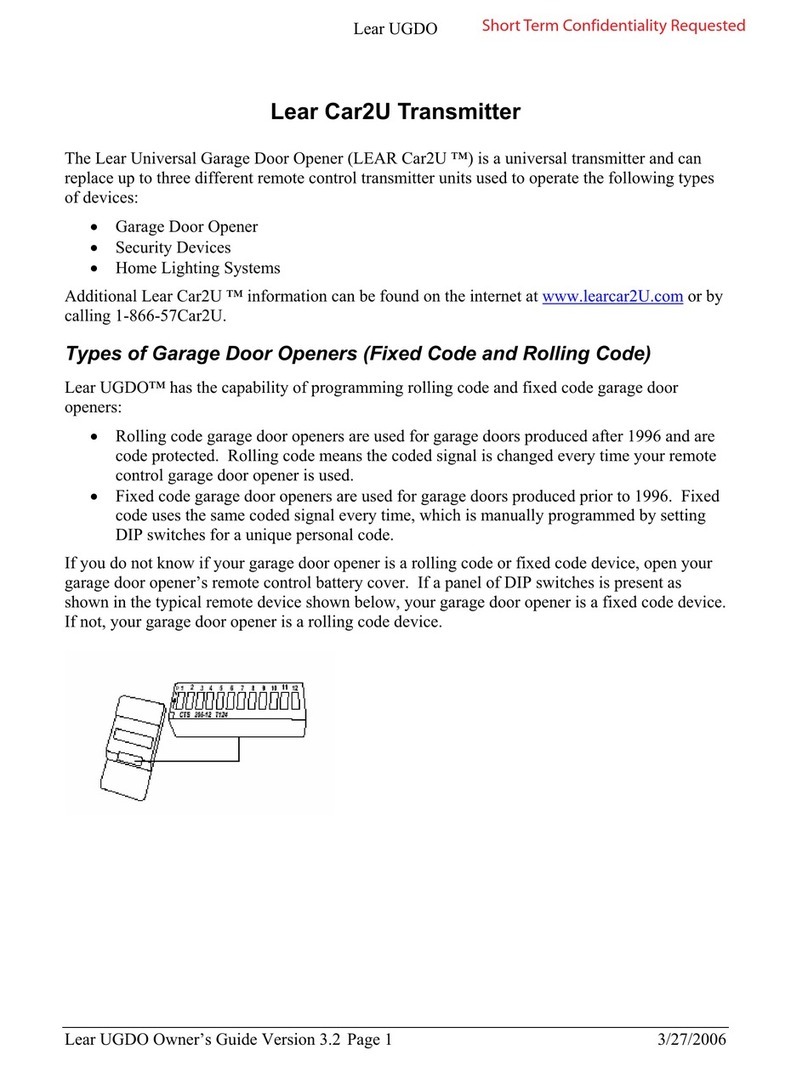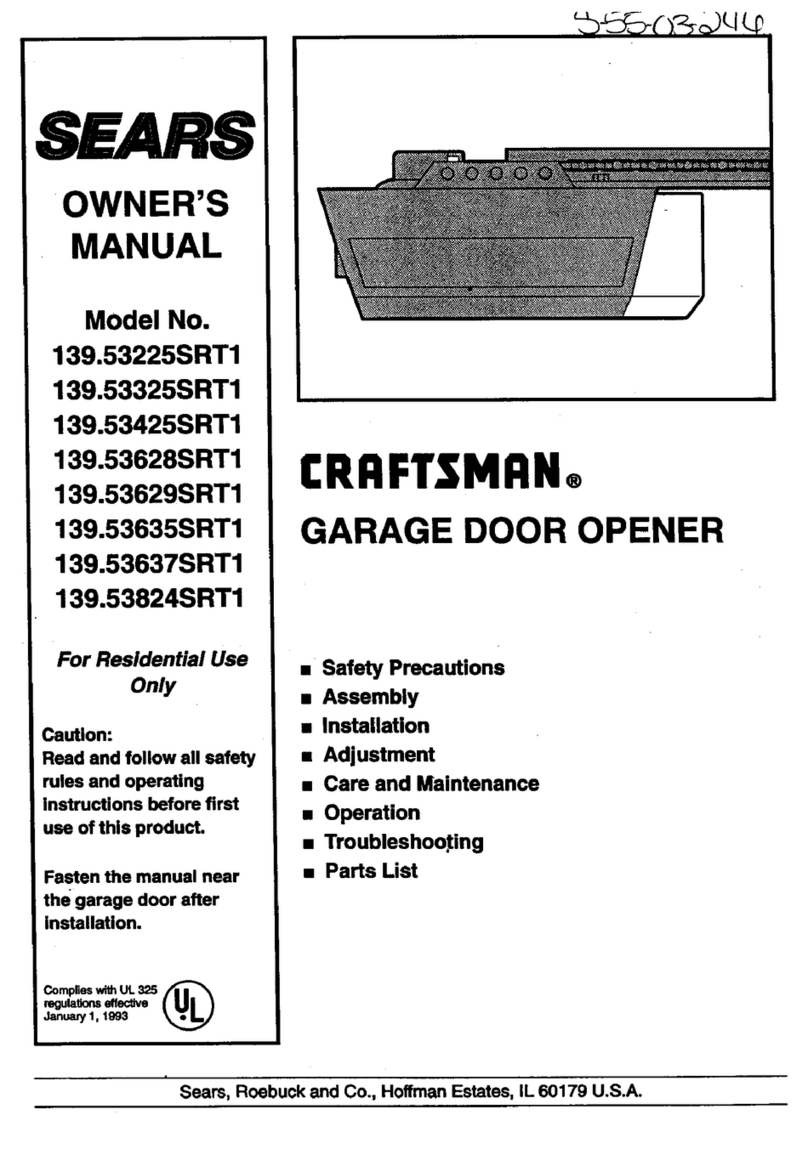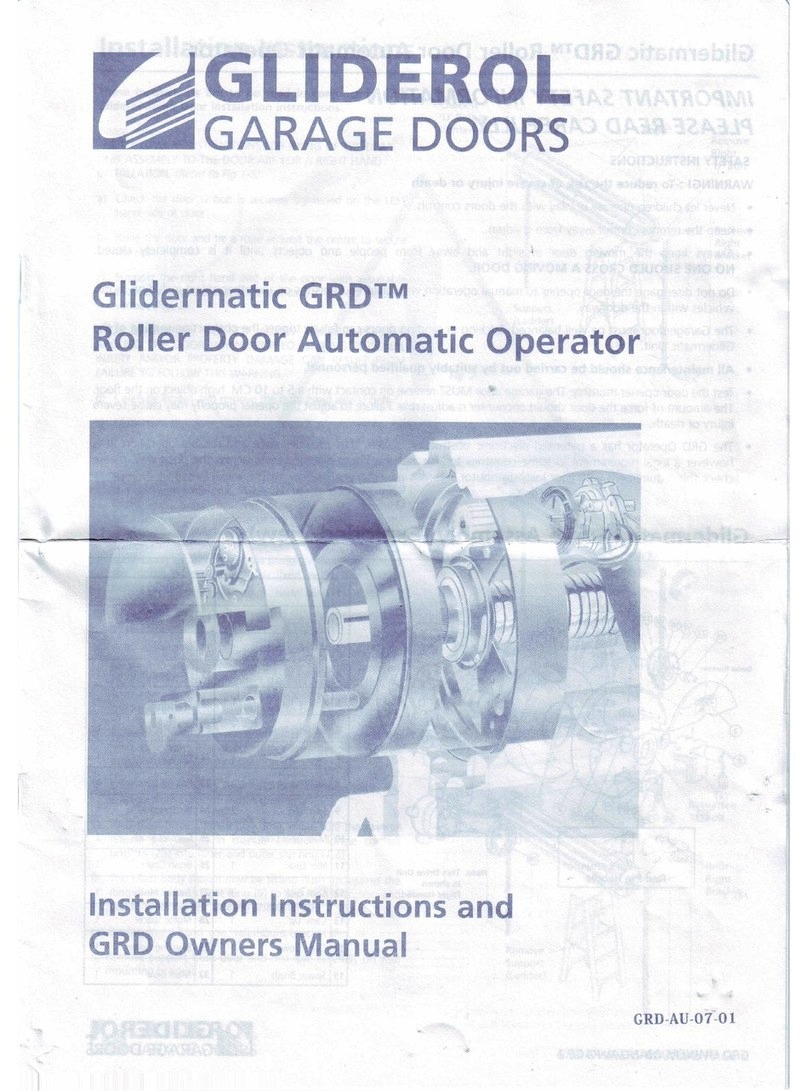Seip SE 130 TS User manual

3V2 SKR433-3
SE 130 TS
English
Installation Instructions
for the garage door operators

2
Content
Information and Remarks
Directives and Regulations
Use of the operators
Garage Doors
The installers declaration of conformity
Older Garage Doors
Important Information for the Installer 3
Instruction for the users
Security Advises for the Installation 4
Installation
Different Conditions for Installation 5
Minimum space above the garage door
Door Arm Extension
Bow Arm Conversion
C-Rail Extension
Pre-Mounting the operator 6
Installing the operator 7
The Emergency Release 8
When there is a second entrance to the garage
When the garage door is the only entrance
Printed Circuit Board: Adjustments and Connections
Devices for Adjustments 9
TEST/RUN-Button (1)
LERN/LEARN-Button (2)
Potentiometer “PRESSURE OPEN/CLOSE“ (3)
Potentiometer “LIGHT“ (4)
Limit-Switch Adjustment and Force Measurement 10
Information
1.) Adjusting the maximum force for the learning-cycle
2.) Starting the learning-mode
3.) The Limit Switch Adjustment
4.) Starting the Learning-Cycle
Quick Reference
Enhanced Adjustments 12
The BOTTOM Soft-Stop
The length of the BOTTOM Soft-Stop may be changed during
the first run of the learning-cycle in closing direction:
Programming the BOTTOM Soft-Mode
Top Soft Mode
Enabling the Top Soft Mode
Reducing the Closing Speed
Why reduce the Closing Speed?
When to reduce the Closing Speed?
Programming the Closing Speed
The most important connectors 14
Push Button and Key Switch
24V DC Supply
230V AC Supply
Receiver-Module
Advanced Connectors 14
Photo-Cell without selftest:
Photo-Cell with selftest
Safety Beam, Hatch Door, Emergency Stop
Modules for Special Functions
Cycle Counter
LED-Lamps 16
LED “TEST“
LED “Diag“
LED “Vp“
LED “SLZ“
LED “LSZ“
LED “SEZ“
LED “SEA“
Special Functions 17
DIP-Switch Settings
Function 1: TOP Soft-Mode
Function 2:Automatic Force Measurement
Force Setting TS75 or TS100
Pre-Warning light before every movement
Full reversion in OPENING direction
No reversion on Security-Beam when door closed
Side Hinged Doors
Remote Control
Programming the Hand Transmitters 18
Basics
Programming Transmitter and Receiver
Clearing the receivers‘ memory
Additional Information 19
Additional Information 19
Criterias influencing the range
Use with a HomeLink© System
Technical Information
Technical Data 20
Optional Special Functions 20
Module “Automatic Closing“ (AZ)
Module “Separated Impulse“ (TO)
Module “One Way Traffic Control“ (EI)
Maintenance:
Wiring 21
Internal Wiring
External connections
Spare Parts 22
Troubleshooting
Troubleshooting 23
Error Messages
Error messages via the operator‘s light
If... then...
Additional messages only via the LED “Diag“
Declaration of Conformity

3
It is within legal regulation and without restriction, to use a
Seip door operator with any garage door that has been ap-
proved for use with other certified door operators!
Directives and Regulations
The operators TS 75 and TS 100 comply to the latest European di-
rectives and regulations. The declaration of conformity is enclosed
at the end of these instructions.
Use of the operators
The operators were designed for the use with up-and-over doors
(tilting and canopy-type) and sectional doors. They can be used
with side-hinged doors using a special conversion-kit.
All garage doors need to be maintained before automation. The
door must be easily opened and closed by hand. A garage door
must not be automated unless it is easy to open and close manu-
ally.
Garage Doors
In January 2001 the European regulations EN12604 and EN12605
became compulsory for garage doors. Before installing an au-
tomatic door operator it must be assured that the garage doors
applies to these regulations (the information can be obtained from
the manufacturers‘ declaration of confirmity). A Seip door opera-
tor may be installed to any door that complies to the regulations.
Should a garage door not be compliant then please refer to the
chapter „older garage doors“.
The installers declaration of conformity
No matter whether a door operator was delivered together with a
garage door or seperately, the installer must issue a declaration of
conformity for the complete installation.
With this declaration the installer assures, that the installation
was made according to the instructions given by the manufactur-
ers (e.g. the installation instructions of the garage door and the
operator). This declaration can only be issued by the installer and
may not be issued from the manufacturer!
If both components comply to the directives and the installation
was made as to the manufacturers instructions the whole installa-
tion will normally be CE-compliant.
Older Garage Doors
When automating an older garage-door the TS-series will still
comply to the regulations - through the automatic force setting
the requested values for forces and reversion will be according to
the regulations.
But it needs to be taken in consideration that most older garage
doors do not meet the regulations EN 12604 and EN 12605
- especially regarding security features. They might still have sharp
edges bearing the danger of severe injuries - for example sectional
doors might not have a finger protection between the sections.
Unfortunately the entire regulations do not mention how to
handle the automation of such an older garage door - the danger
basically is not the automation but the construction of the door.
Therefore we strongly recommend to
- check the garage door for sharp edges bearing danger when the
door is moving; take any necessary action to avoid the dangers
and make the door safer
- check the doors‘ springs and readjust them if necessary
- grease or oil the pivotal points and rollers of the garage door
- check that the door may be easily used by hand
If, however, the dangers cannot be avoided we recommend to use
the automatic pre-warning function of the operator. The opera-
tors‘ lighting will then be blinking for approx. 5 sec. before every
movement of the garage door. People inside the garage will be
warned before the opening and can step back from the garage
door in time.
Instruction for the users
Please instruct the users as follows:
- Use of the hand transmitter
- Use of the emergency release in case of a power failure
- Hand over the separate „User Manual“ to the customer
- Inform the user about the Security Advises in the User Manual
Important Information for the Installer
Information and Remarks

4
Security Advises for the Installation
Information and Remarks
Important Safety Instructions for Installation
WARNING: INCORRECT INSTALLATION CAN LEAD TO SEVERE
INJURY
Follow all Installation Instructions.
- Read page 3 of this instruction carefully before the installation
- Before installing the drive, remove unnecessary ropes from the
existing installation
- Maintain the garage door according to the advises on page 3
and to the door manufacturer’s manual
- If possible, install the drive at a height of at least 2,10 m and the
manual release at a height less than 1,80 m
- Locate the push-button within sight of the door but away from
moving parts and at a minimum height of 1,50 m
- Fix the label warning against entrapment next to the push-but-
ton
- The label fixed to the manual release may not be removed
- After installation, ensure that the mechanism is properly adjusted
and that the drive reverses when the door contacts a 40 mm high
object placed on the floor.

5
Different Conditions for Installation
Installation
35mm Minimum
Minimum space above the garage door
C-Rail Extension
Bow Arm Conversion
Door Arm Extension
Before installing the operator you should check the garage for the
conditions of installation. You will need optional extras in either of
the following situations:
If the garage door is higher than 2.800mm you will need a c-rail
extension. An extension-rail of 1.600mm is available.
The operator may be extended by a maximum of 3.200mm - the
maximum height of a garage door is 6.000mm.
For a canopy type garage door (inside turning door) you will need
a bow arm conversion to automate the door.
Inside turning doors are equipped with a roler on each side at the
bottom of the door. With these rollers the door cannot tilt outside
- an automation without the bow arm conversion is not possible.
Should the minimum space between the garage door and the ceil-
ing be smaller than 35mm then a door arm extension is needed.
For an extension you can use a metal beam from any DIY-market.
The beam should not be shorter than the door‘s height.

(1)
(1)
(2)
(1)
(1) (2)
(3)
(3)
(4)
6
The motor head unit and the C-rail are shipped in two seperate
packages. The C-rail must be fixed to the motor head first. Please
procede as described below and be careful not to twist the chain
(it is recommended to slide the C-rail and not to lift it from the
floor).
1. Slide the C-rail part (no.1) completely into the motor heads‘
coupling piece.
2. Turn the operator aside and tighten the screws of the motor
heads‘ coupling piece. Place the chain on the cog-wheel.
3. Turn the operator back into its‘ original position. Set the C-rail
part (no. 2) in the C-rail coupling piece (no.3) at an angle , inser-
ting it from above as shown.
4. Press down the C-rail (no. 2) to tension the chain. Slide the
coupling-piece to the stop.
5. Turn the operator aside and screw the milled nuts into the C-rail
coupling piece.
The operator is now readily premounted for installation.
Should the chain tension appear too low, it can be adjusted using
the manual chain tensioning-facility (4).
Pre-Mounting the operator
Installation

(1)
(2)
(2a)
(3)
(3a)
(4)
(5)
(6)
7
Installing the operator
Installation
Meassure the distance between the ceiling and the highest point
reached by the garage door (1).
The minimum-headroom necessary for mounting the operator is
35 mm. If there is less headroom please pay attention to page 5.
The front fixing angle can be mounted either at the lintel or at the
ceiling.
1. Meassure the middle of your garage door and make a mark on
the lintel and the top of your door (2+2a).
2. Fix the front fixing angle in the middle either at the lintel or at
the ceiling. (We recommend the lintel if possible) (2+2a).
3. Attach the C-rail to the front fixing angle (3). Put a carton piece
under the motor head unit to avoid damages.
4. To fix the motor head to the ceiling we recommend you to use
a ladder (4). When the operator is laying on the ladder you can
open the garage-door. Adjust the C-rail according to the mark you
made in the middle of the garage-door.
Fix the operator to the ceiling when you have made sure the C-rail
is running straight to the front.
5. Now fix the door arm to the garage door (5). Take care that the
angle between the operator and the door arm does not exceed a
max. of 45° (it may be lower).
6. Before running the operator disengage the door‘s lock-
ing-bolts otherwise the operator cannot open the door. This
could result in damage to the operator and/or the garage
door. The self-locking gear of the operator will ensure that the
door cannot be opened manually. If you require additional secu-
rity, ie using door bolts, please ask your dealer for our locking set,
which is available as an optional extra.

8
Installation
In case of a power failure the garage door can be opened by
hand. Therefore the operator first needs to be released.
When the garage door is the only entrance
It is necessary to connect the emergency release to the door‘s
handle (pic. 1) otherwise the garage cannot be accessed in a
power failure situation.
Procede as follows:
1. Find out in which direction the door handle moves when open-
ing the door.
2. Drill a hole in that side of the door handle which turns down-
wards.
3. Thread the cable through the hole and fix it with the enclosed
metal-clamps. Be carefull not to put a high tension on the emer-
gency release cable - the operator then might release from the
garage-door during a normal opening cycle.
4. Check the function of the emergency release together with a
second person. Stay inside the garage and close the door with
the operator. Let the second person open the door manually with
the door keys. If this works, the emergency-release is mounted
properly.
Do not leave the garage and close the garage-door with the
operator before you have tested the emergency-release!
The Emergency Release
When there is a second entrance to the garage
You can use the supplied handle for the emergency release (pic.
2).
Thread the emergency release cable through the handle.
Fix the metal clamps to the cable where the handle shall be
placed.
Shorten the cable below the metal clamps - the handle is now be-
ing held by the clamps.
In case of a power failure the user can now open the garage
door by releasing the operator with the handle for the emergency
release.
Pic. 1
Pic. 2

1
2
34
9
Devices for Adjustments
Printed Circuit Board: Adjustments and Connections
TEST/RUN-Button (1)
With this button you put the operator into operation. The button
works on the OPEN-STOP-CLOSE principle, e.g. the first push
opens the door, the second push stops the door and the third
push closes the door etc.
The LED-lamp “TEST“ is switched on as long as you press the
TEST-button and shows that the impulse was received an recog-
nised by the electronics.
LERN/LEARN-Button (2)
This button has to functions:
1. Learning the forces
2. Registering (learning) a hand-transmitter
The LERN/LEARN-button must be pressed for approx. 3 sec.; the
button can be released once the operator‘s light starts blinking.
Whilst the operator‘s light is blinking you can either register a new
hand-transmitter by pushing the hand transmitters button O R
you may start the learning of forces by pressing the button once
again.
Details on both procedures can be obtained from the chapters
“Automatic Force Setting“ and “Remote Control“.
Potentiometer “PRESSURE OPEN/CLOSE“ (3)
With these potentiometers you must adjust the maximum force
for the force learning cycle (please refer to the chapter “Automat-
ic Force Setting“) separately for OPENING and CLOSING direction.
The operator will never override the adjusted forces, neither dur-
ing the learning cycle nor in later use!
The maximum forces are shown in %. Dependant on the operator
model this means:
max.force
%age
Operator with
100 kg max.
20% 20 kg approx.
50% 50 kg approx.
70% 70 kg approx.
100% 100 kg
Potentiometer “LIGHT“ (4)
With this potentiometer the time for the internal lighting is ad-
justed in seconds. Values from 80 to 240 seconds are adjustable.
This page only shows the functions of the buttons and potentiometers on the P.C.B.. To programme the operator ple-
ase refer to page 10 onwards.

1
2
3
10
Limit-Switch Adjustment and Force Measurement
Printed Circuit Board: Adjustments and Connections
Information
To use the operator the following steps must be carried out, to adjust the
limit-switches and to learn the required force. Without these adjust-
ments the operator will only run for the factory set distance when
pressing the TEST-button.
The limit-switch adjustment and the force-learning are both done in one
combined programming step. The operator needs to be set into program-
ming-mode - the programming-mode is indicated by the blinking opera-
tor’s light. During the programming-mode the limit-switch setting is done
first, followed by the force-setting.
The procedure of adjustments:
1.) Adjustment of the maximum force for learning-mode
2.) Start of programming-mode
3.) OPENING limit-switch
b.) Adjustment CLOSING limit-switch
4.) Start the learning-cycle for force and distance.
Descriptions of each step will be found in the following text.
1.) Adjusting the maximum force for the learning-cycle
The force adjusted via the potentiometers “FORCE OPEN“ and “FORCE
CLOSE“ determines the maximum forces for the learning cycle and in later
use. The factory setting is 60% for both. On smaller, easy running doors a
force of 40% will be sufficient.
2.) Starting the learning-mode
Press the LERN/LEARN button (2) on the main electronics for approx. 3 sec-
onds. When the operator’s light begins blinking - release the LERN/LEARN
button.
The operator now runs in learning-mode. The learning-mode runs
without time-limit - there is no need to rush with the following
adjustments.
3.) The Limit Switch Adjustment
In CLOSING-position the garage door should not be forced hard onto the
doors‘ frame. If it is closed to firmly then the operator will reverse after
each CLOSING and the garage door will remain open for approx. 5 cm.
Basics: During the learning-mode the operator will follow the limit-switch-
es automatically when these are moved.
E.g.: The operator hits the CLOSING limit-switch but the garage-door still
is not completely closed. You can now slide the red limit-switch actuator
off the CLOSING limit-switch - the operator will automatically start running
in CLOSING direction until it hits the CLOSING limit-switch again. You do
not have to press the TEST/RUN button to activate the operator.
The procedure works vice-versa in OPENING direction.
Attention: the operator only follows the limit-switch in ONE direction - the
CLOSING limit-switch is only followed in CLOSING direction, the OPENING
limit-switch is only followed in OPENING direction.
To run the operator in another direction you have to press the TEST/RUN
button.
IMPORTANT INFORMATION PRIOR TO PROGRAMMING!
The programming described on this and the following page will programme the operator with factory
pre-set values for Soft-Modes and Closing Speed.
Dependant on the type and the weight of the garage door it might be necessary to reduce
the Closing Speed. On page 13 you will find a weight table and a description on how to programme
the Closing Speed.
If the Soft-Modes require readjustment, please refer to page 12.
To change the standard values it is allways necessary to run another complete learning cycle - the old
values will then be substituted by the new measurements and adjustments.
Old values can allways be overwritten by starting and completing a new learning cycle.
Pictures:
1: TEST/RUN-Button
2: LERN/LEARN-But-
ton
3: Potentiometer for
Force Adjustment

TEST/RUN
LERN/LEARN
TEST/RUN
LERN/LEARN
11
Limit-Switch Adjustment and Force Measurement
Printed Circuit Board: Adjustments and Connections
Quick Reference
1.) Force Adjustment Adjust the maximum force for
OPENING and CLOSING direction
for the learning cycle
2.) Start programming
mode
Press the LERN/LEARN button for
approx. 3 seconds. The operator’s
light begins blinking - release the
LERN/LEARN button
3.) Limit Switch Adjustment a.) Adjust OPENING limit switch
b.) Adjust CLOSING limit switch
(The operator can be run
in OPENING and CLOSING
direction using the TEST/RUN
button)
4.) Start learning cycle The garage door is closed and
the operators hits the CLOSING
limit switch
Press the LERN/LEARN button
shortly
The operator does three runs
(OPENING-CLOSING-OPENING)
The learning cycle stops after the three runs. The garage door
is then opened and the operator’s light stops blinking. The pro-
gramming is now complete.
5.) You may now proceed with chapter “Remote Control“ on
page 16
The operator’s light will be blinking throughout the whole procedure of
setting the limit switch.
3.)a.) Adjusting the OPENING limit switch
1.) Run the operator in OPENING direction using the TEST/RUN button (1)
(the button follows the principle OPEN-STOP-CLOSE etc., e.g. first impulse
OPEN, second impulse STOP, third impulse CLOSE etc.)
2.) When the garage door is almost opened to maximum you have to stop
the operator using the TEST/RUN button. Then slide the OPENING limit
switch actuator so that it hits the limit-switch.
3.) When the OPENING limit switch is hit before the garage door is opened
to maximum then simply slide the red limit switch actuator further in
OPENING direction - the operator will follow the movement.
3.)a.) Adjusting the CLOSING limit-switch
1.) Run the operator in CLOSING direction using the TEST/RUN button (1)
(the button follows the principle OPEN-STOP-CLOSE etc., e.g. first impulse
OPEN, second impulse STOP, third impulse CLOSE etc.)
2.) When the garage door is closed you have to stop the operator using
the TEST/RUN button. Then slide the OPENING limit switch actuator so that
it hits the limit switch.
3.) When the CLOSING limit switch is hit before the garage door is closed
then simply slide the red limit switch actuator further in CLOSING direction
- the operator will follow the movement.
4.) Starting the Learning-Cycle
Once the limit-switches are adjusted, press the LERN/LEARN
button once again. The operator then starts the learning cycle:
- moving towards the limit-switch OPEN
- closing the door
- opening the door
- closing the door
The learning-cycle will be made completely automatic - you only have to
intervene, when the CLOSING Soft-Stop shall either be changed or disab-
led (please refer to the information box on page 10).
Once the learning-cycle is completed, the operator stops blinking; the
garage is in closed position.
After the learning-cycle the operator is completely programmed - please
proceede to the chapter „Remote-Control“.

TEST/RUN
LERN/LEARN
1
23456
LERN/LEARN
TEST/RUN
1
23456
LERN/LEARN
TEST/RUN
TEST/RUN
LERN/LEARN
12
Quick Reference „Programming the BOTTOM Soft-Mode“
1.) First learning cycle in
CLOSING direction
Keep the LERN/LEARN button
pressed during the first run in
CLOSING direction and keep it
pressed -the operator increases
speed
2.) The operator is running
in CLOSING direction with
increased speed
Release the LERN/LEARN button
at the position where the soft-
stop shall start in future.
If the LEARN button is kept
pressed until the door is com-
pletely shut, then the soft-stop
will be disabled.
3.) The operator reaches the CLOSED position. It will proceed
with the learning-cycle (two more runs) before finishing the pro-
gramming. The CLOSING Soft-Stop will then be set as to your
adjustments.
The BOTTOM Soft-Stop
The length of the BOTTOM Soft-Stop may be changed during the
first run of the learning-cycle in closing direction:
- Extending the BOTTOM Soft-Stop is recommended, if the
garage door slams on closing.
- Reducing or disabling the BOTTOM Soft-Stop is recommen-
ded, when the bottom of the garage door does not close
completely. Expecially when mechanical spring-locks are installed,
these might not engage. When the BOTTOM Soft-Stop is
disabled, the garage door reaches the closing position with a
higher speed. This gives the door a higher momentum and the
bottom can fall into the doors‘ frame - the locks can then engage.
Programming the BOTTOM Soft-Mode
The length of the soft-stop can be adjusted during the first au-
tomatic measurement-run in closing direction. Please proceed as
described below:
1. Start the learning cycle (refer to page 11)
2. the operator runs in closing direction with low speed
3. press the LERN/LEARN button and keep it pressed - the opera-
tor is now increasing the speed
4. release the LERN/LEARN button at the position where the soft-
stop shall begin (the operator will store this position as the
beginning of the BOTTOM soft-stop)
If the Soft-Stop is to be disabled, then the LEARN button must be
pressed until the door is completely closed.
5. the operator will reduce speed with a short delay and then
reach the closing position
6. the operator will proceede with the remaining measurement-
runs
When the operators‘ light stops blinking, all measured values
are saved in the memory - the BOTTOM soft-stop now is in the
programmed position.
Quick Reference „Enabling the Top Soft Mode“
1.) Set DIP-Switch No. 1 to OFF before
starting the learning cycle
2.) Start the learning cycle
(if necessary the closing soft stop
can now be ammended as
mentioned in the previous
chapter)
3.) Set DIP-Switch No. 1 to ON after
the learning cycle is completed
(please refer to page 17 „DIP-Switch
Settings“)
Bottom Soft-Stop
Top Soft Mode
Enhanced Adjustments
Printed Circuit Board: Adjustments and Connections
Top Soft Mode
Using the standard programming will disable the Top Soft Mode.
For up-and-over doors and sectional doors this standard setting
will not require any changes.
On canopy doors the Top Soft Mode might need to be enabled,
when the operator constantly reverses after starting to close the
garage door.
Enabling the Top Soft Mode
Before starting the learning cycle, DIP-switch no. 1 must be set to
OFF. The switch must remain in OFF position during the complete
learning cycle.
Once it is finished (e.g. the operators light stops blinking), DIP-
switch no. 1 must be set to ON position again, otherwise the
operator will not work on automatic force (please refer to page 17
„DIP-switch settings“).
Hint: although the Top Soft Mode is now disabled, the operator
will not instantly start running with full speed when closing the
door. To prevent excessive wear to the motor gear, the speed will
be increased continuosely from zero to maximum speed.

LERN/LEARN
TEST/RUN
LERN/LEARN
TEST/RUN
TEST
Diag
Vp
TEST/RUN
LERN/LEARN
LERN/LEARN
TEST/RUN
1
2
3
4
5
6
7
8
0 - 55 56 - 75 76 - 95 96 -115 116 -170
8
7
6
5
4
13
Enhanced Adjustments
Reducing the Closing Speed
When using the standard programming procedure, then the clo-
sing speed is automatically set to maximum; for most
CE compliant garage doors no changes are necessary.
Why reduce the Closing Speed?
Reducing the closing speed will also reduce the forces and the
time for reversion which appear when the garage door hits an
obstacle.
The greater the weight of a garage door, the higher the mass that
needs to be moved, stopped and reversed in case of detection of
an obstacle. Especially on heavy doors this momentum may result
in a short peak force, leading to higher forces on the leading edge
. The lower the closing speed, the lower the momentum of force
and the peak forces.
When to reduce the Closing Speed?
The table besides provides information on suggested closing
speeds for different door weights. For new, CE-compliant doors
you should find the doors weight either labelled on the door or in
the instructions. Adjust the closing speed according to this infor-
mation, as far as a change is required.
When automating an older, non CE-compliant garage door, we
strongly recommend to use speed level 4 or lower (please also
refer to page 3).
Programming the Closing Speed
The programming of the closing speed must be made before run-
ning the learning cycle. If, however, the learning cycle was already
completed, it must be run again after changing the closing speed.
1.) The operator is switched off
2.) Press the red LEARN-button and keep it pressed. Press the
black TEST-button in addition and keep both buttons pressed for
approx. 3 seconds.
3.) The operators light starts blinking and the red LED „Diag“
blinks in intervalls; the buttons can now be released.
4.) The LED „Diag“ is blinking in intervalls (8 blinks followed by a
short break) - indicating the factory pre-set speed level 8.
5.) Each press of the TEST-button will reduce the closing speed by
one level, each press of the LEARN-button will increase the speed.
After readjusting the speed, wait for the short break between the
intervalls and count the number of blinks from there to check the
entirely adjusted speed level.
6.) Once you reached the wanted closing speed level, press the
LEARN-button and in addition the TEST-button and keep both
pressed for approx. 1 second.
7.) The closing speed is now adjusted and the operator is now
in the ordinary learning mode (the operators light and the LED
„Diag“ are blinking constantly). If the limit-switches were adjusted
already, you can now start the learning cycle by shortly pressing
the red LEARN-button.
Otherwise you can now adjust the limit-switches (please refer to
pages 10 and 11) and then start the learning cycle.
Quick Reference „Ajusting the Closing Speed“
1.) First press LEARN button,
then in addition TEST-button,
keep both pressed for 3 sec.
The operators light begins blinking
when the buttons are pressed
2.) Red LED „Diag“ begins to
blink in intervalls
Release both buttons when the LED
„Diag“ starts blinking
Factory pre-set: 8 blinks followed by
a short break (= max. speed)
3.) Reduction of speed by
pressing the TEST button
Each press on the TEST button
reduces the closing speed by one
level (pressing the LERN button will
increase the speed).
Wait for the break and count the
number of blinks from there to
check the entire adjustment.
4.) First press LEARN button,
then in addition TEST-button
and release both
The operator is now in the ordinary
learning mode; the operators light
and the LED „Diag“ are now blin-
king simultaneousely.
5.) Adjust the limit-switches and start the learning-cycle.
If changes to the soft modes are necessary, then please refer to page
12.
If the limit-switches had been adjusted previousely, the learning-cycle
can be started instantly by shortly pressing the LERN button.
Speed Level (No. of blinks of
the LED „Diag“)
Closing Speed (cm/sec.)
1 6 cm/sec.
2 6,5 cm/sec.
3 7,5 cm/sec.
4 9,5 cm/sec.
5 10,5 cm/sec.
6 11,5 cm/sec.
7 12,5 cm/sec.
8 14,5 cm/sec.
Speed Level
Door
Weight
in kg
Printed Circuit Board: Adjustments and Connections

D
C
H
G +
J
I +
24 V
24 V
N.C.
8,2 kW
D
C
H
G +
J
I +
24 V
24 V
N.C.
8,2 kW
+
+
14
The most important connectors
Printed Circuit Board: Adjustments and Connections
Component Connector Function
Push Button and
Key Switch
A + B Floating connector for push button and key switch:no electricity to come into contact
with these connectors!
When using an external receiver the impulse wires are connected to this terminal.
24V DC Supply G + H 24V DC power supply for external components (external receiver, photo-cell), a maxi-
mum of 200 mAmp. is allowed.
230V AC Supply M + N 230V AC power supply for external components. Shortcuts created by external compo-
nents on this connector will influence the house fuse directly.
Receiver-Module HF-Modul /
Receiver-Card
Plug for Seip remote-receiver cards.
Advanced Connectors
Component
Photo-Cell without selftest:
C + D
(with 8,2 kOhm
resistor)
Wiring:
Photo-Cell with selftest
C + D
(Photo-Cell receiver)
I + J
(Photo-Cell trans-
mitter)
The main electronics provides the possibility of testing the photo-cell before every movement - within milliseconds a malfunc-
tion of the photo-cell is simulated. To enable the main-electronics for this testing the impulse cables of the photo-cells‘ trans-
mitter must be connected to I + J and the impulse cables of the photo-cell’s receiver must be connected to C + D.
ATTENTION! If you want to use this selftest option, you must connect the photo-cell before the limit switch setting
and force adjustment, otherwise there will be no selftest in later use.
Transmitter
Receiver
Transmitter
Receiver

F
E
8,2 kW
F
E
8,2 kW
F
E
8,2 kW
15
Advanced Connectors
Printed Circuit Board: Adjustments and Connections
Safety Beam, Hatch Door, Emergency Stop
E + F
(mit 8,2 kOhm
Auswertung)
Function
This connector is continuosely checked during opening and closing procedures. When the contact is opened (e.g. an obstacle
is detected), then the operators stops and reverses shortly. If more than one component is connected to this connector, then
they must be connected serial! The connector may be used for the following componentes:
1.) Safety-Beam
This device is normally equipped with a 8.2 kOhm resistor. Therefore you have to remove the 8.2 kOhm resistor from the con-
nectors E + F before connecting the security-beam.
2.) Hatch-Door Switch
A hatch-door within the garage door can be secured with a switch - when the switch is not activated (e.g. the hatch-door
stands open) the operator will not work.
3.) Emergency Stop - button which locks in when pressed once and which keeps the contact open (e.g. operator cannot be
used)
Security Beam (8,2 kOhm resistor connected in line):
Hatch-Door Switch (8,2 kOhm resistor connected in line):
Security Beam and Hatch-Door (connected in line):
Modules for Special Functions
„Versions Mod-
ule“
Plug for optional modules providing special functions:
- Automatic Closing (AZ)
- One-Way traffic control (EI) with traffic-light regulation
- Dead-Man-Function (TO) (push-button needs to be pressed during the whole CLOSING cycle, otherwise the operator stops)
Cycle Counter
LA counter for OPENING/CLOSING cycles can be connected (24V)

16
LED-Lamps
Printed Circuit Board: Adjustments and Connections
LED Function ON OFF
LED “TEST“ “ON“ when a device connected to A+B (push-button, key-switch)
or the electronics‘ TEST-button gives an impulse
Incoming impulse No incoming im-
pulse
LED “Diag“ “ON“ when an impulse from a programmed hand-transmitter is
received.
More functions of this LED are named in the chapters “Learning
the force“, “Remote-Control“ and “Error messages“.
Incoming impulse
from a programmed
hand-transmitter
No incoming im-
pulse from a hand-
transmitter
LED “Vp“ “ON“ when mains power supply is o.k. Mains power supply
o.k.
No mains power
LED “SLZ“ Photo-Cell
Possible Errors:
- an obstacle is registered by the photo-cell
- the connection wires might be broken or a short-cut was created
- the photo cell is damaged
- the 8.2 kOhm resistor is not connected properly
Error or obstacle o.k.
LED “LSZ“ Security Contact / Hatch-Door Switch
Possible Errors:
- the security beam registers an obstacle
- the hatch-door is open
- the connection wires might be broken or a short-cut was created
- Security beam or hatch-door switch is damaged
- the 8.2 kOhm resistor is not connected properly
Error or obstacle o.k.
LED “SEZ“ Checks the function of the CLOSING limit switch - when the limit
switch is activated, the LED goes on. If it does not, then the limit
switch is damaged.
activated not activated
LED “SEA“ Checks the function of the OPENING limit switch - when the limit
switch is activated, the LED goes on. If it does not, then the limit
switch is damaged.
activated not activated

DIP
1 2 3 4 5 6
17
Printed Circuit Board: Adjustments and Connections
Special Functions
DIP-Switch Settings
DIP-Switch Function ON OFF
1Attention: Double-Function!
Function 1: TOP Soft-Mode
Standard setting: ON
Before and during the learning-cycle DIP-switch no. 1 determines whether the TOP Soft-Mode shall be
enabled or disabled (ON: Top Soft-Mode disabled, OFF: Top Soft-Mode enabled)
Function 2:Automatic Force Measurement
Standard setting: ON
After the learning cycle was completed (the operator stopped blinking) DIP-switch no. 1 determines
whether the operator is running with automatic or with manual force
ATTENTION! In countries of the European Union the operator must be run with automatic
force measurement - running it on manual force is illegal!
In non-European countries the manual force may be used. Please pay attention to the fact, that the
learning cycles (chapter “Limit-Switch Settings and Force Adjustment“, pages 10+11) must also be done
when manual force is chosen!
Yes
Yes
No
No
2Force Setting TS75 or TS100
Standard setting for TS75: ON
Standard setting for TS100: OFF
This switch optimizes the automatic force for the type of motor used (TS75: motor with 75Nm, TS100:
motor with 110Nm).
The switch must remain in the factory pre-set position for the operator model! Other wise the adjust-
ment of the automatic force might not be within the entire regulations.
TS75 TS100
3Pre-Warning light before every movement
Standard setting: OFF
When choosing ON a pre-warning of appox. 4 sec. will be made before each movement of the garage
door.
Yes No
4Full reversion in OPENING direction
Standard setting: ON
The operator reverses approx. 20 cm when an obstacle in CLOSING direction is recognised. If the switch
is set to ON the operator will reverse completely in OPENING direction until the OPENING limit switch is
reached.
Yes No
5No reversion on Security-Beam when door closed
Standard setting: ON
This function is only needed when a security-beam is connected. In garages with an uneven floor the
security-beam might lead to unwanted reversion when the garage door is almost closed. If the switch is
set to ON the revertion in SOFT-STOP will be prevented - the operator simply stops and the door remains
closed.
HINT! Using this function might lead to problems programming new hand-transmitters via an existing
hand-transmitter. For that programming the operator needs to hit the CLOSING limit-switch. Please also
refer to chapter “Remote Control“
No Yes
6Side Hinged Doors
Standard setting: OFF
For use with a side hinged door the OPENING and CLOSING directions need to be reversed - setting this
switch to ON will do that automatically.
Yes No

TEST/RUN
LERN/LEARN
18
Remote Control
Programming the Hand Transmitters
Basics
As standard the operator is supplied with a 433 MHz AM re-
mote control set. The coding is done via rolling code - the code
is changed after each impulse; receiver and transmitter agree com-
pletely automatic about the next code to be used. New codes will
be chosen out of a pool of billions of possible codes.
The 4-channel MIDI transmitter is standard equipment, the 2-
channel MINI transmitter is available as an optional extra.
If your operator is equipped with another remote control set,
please refer to the manufacturers instructions for programming.
Programming Transmitter and Receiver
To use a hand transmitter it must first be registered (programmed)
by the receiver. Only one hand transmitter button can be used for
one receiver.
Registering the first hand transmitter
The first hand transmitter (e.g. no hand transmitter has been
registered for the receiver, yet) must be learned directly via the
operators‘ main electronic:
1. Press the LERN/LEARN button on the main electronic for approx.
3 seconds until the operator’s light starts blinking and release the
LERN/LEARN button.
2. Press the hand transmitter button you want to register to the
receiver - the operators’ light stops blinking when the transmit-
ters’ signal was received. The transmitter is now registered.
Registering additional hand transmitters
When the receiver has registered at least one hand transmitter,
you may program additional hand transmitters from a distance:
1. The garage door must be closed
2. Open the garage door approx. 50 cm and close it again.
3. After the garage door is closed you have got 10 seconds to
press the buttons 1+2 simultaneously on the registered hand
transmitter - the operator’s light then starts blinking.
4. The light will keep blinking for another 10 seconds - during
that period of time you must press the button on the new hand
transmitter that you want to use with the operator. Once the new
transmitter is registered the operator’s light stops blinking.
The procedure must be repeated for each new hand transmitter.
Clearing the receivers‘ memory
Keep the LERN/LEARN button pressed for approx. 15 sec.. The
operators‘ light and the red LED „Diag“ will start blinking after 3
seconds. After another 10 seconds the red LED „DIAG“ will glow
constantly. You can then release the LERN/LEARN button.
All previously programmed hand transmitters are now clea-
red from the receivers‘ memory.
Quick reference: programming the first hand transmitter
1.) Keep the LERN/LEARN
button pressed for approx.
3 sec.
The operators‘ light will start
blinking
2.) Press the hand transmit-
ter button you want to use
The operators‘ light stops
blinking - the transmitter was
succesfully programmed
Quick reference: Programming additional hand transmit-
ters from a distance
Remark: additional hand transmitters can be programmed
either like the first transmitter or from a distance as explained
below:
1.) Open the garage door
for approx. 50 cm and close
it again
After the garage door is closed
you have got 10 seconds to pro-
ceed to step 2)
2.) Press buttons 1+2
simultaneously on any
registered transmitter for
3 sec.
The operators‘ begins blinking
- release the hand transmitters‘
buttons
3.) Take the new hand
transmitter and press the
button you want to use
shortly
The operators‘ light stops
blinking - the hand transmitter
was successfully programmed

19
Remote Control
Criterias influencing the range
The TS operators are equipped with a high quality remote
control set as a standard!
Nevertheless the remote control is the part of the operator, which
might be influenced by circumstances in the surroundings of the
garage. With our standard remote control you might reach a
range of more than 100 meters. In areas with high disturbances
the range will still be approx. 50 meters.
The range might be influenced by:
- old batteries in the hand transmitter - if you should experience
a problem with the range, please change the batteries first. The
lower the batteries run the lower the range will be.
- Building materials of the garage
In a garage made of concrete and steel you might reach a lower
range than in an ordinary garage build of stone. The more steel
was used for the walls the shorter the range of your remote-con-
trol.
Remote-control activity in the area
Radio and television transmitters close to your garage might
reduce the range.
Older baby-phones
Especially older baby-phones might influence the range of the
remote control severely. These devices send strong signals via the
houses internal power supply net. These signals also intrude other
devices via the wall plug, as eg the operator.
It is extremely unlikely that the range will drop to an unacceptable
distance. If, however, problems should occur we will like to be
helpful.
Please avoid dropping the hand transmitter - parts
could be damaged inside the transmitter. That might
lead to malfunctions!
Use with a HomeLink© System
The HomeLink© System is becoming more and more popular in
private households. Most frequently it is being used in cars - the
HomeLink© module is integrated in the car. It allows the driver to
activate the door operator with a push of button that is installed
in his car. Once programmed, the driver does not need the hand
transmitter to access the garage with his car.
The standard remote control supplied with the TS-series is
compatible with HomeLink© systems Software Revision 6 or
higher. Older Software Revisions are not supported. Information
on the Software Revision in your car can be obtained from the
cars documentations.
Information on how to program your HomeLink© device can
either be obtained from your cars documentations or from the
internet site www.eurohomelink.com.
4-channel MIDI transmitter,
433 MHz, rolling code
Usable types of batteries: C2032
Voltage: 3V
Used batteries must be disposed according to national
laws!
2-channel MINI transmitter (optional extra),
433 MHz, rolling code
Two batteries, type CR1616 or DL1616 are required.
Voltage: 2* 3V (=6V)
Used batteries must be disposed according to national
laws!
Two Batteries

20
SE 130 TS
Maximum Pulling Force (adjustable) 100 kg (+/- 4%)
Force-Setting for Operation automatic
Motor 24V DC, low-noise
Running Speed 14,5 cm/sec.
Speed in Soft Mode 8 cm/sec.
Duty Cycle 80%
Power Consumption in Stand By 2,3 watts
Power Supply 190-250V AC
Transformer 230V AC, 24V DC
Pre-Warning Light adjustable
Stop on Security Beam in Closing Direction adjustable
Automation of Side Hinged Doors adjustable
Nett Running Length 2.900 mm
Max. Running Length with Extension 5.900 mm
Overall Length 3.420 mm
Height Motor Head 170 mm
Length Motor Head 370 mm
Width Motor Head 260 mm
Minimum Space above the door 45 mm
Weight including packaging 32 kg
Noise Level ≤ 60 dB(A)
Technical Data
For the TS-series operators we provide plug-on module cards for
advanced functions:
Module “Automatic Closing“ (AZ)
For automatic closing of the garage after an adjustable time from
80 to 240 seconds.
The card is also equipped with a connector giving an impulse for
one second when the garage door is opened - an automatic exter-
nal light can be connected here.
Special functions as “fast closing“ (the garage door will be closed
as soon as the car passed the photo cell) and “additional photo-
cell in opening direction“ are adjustable on the module-card.
Module “Separated Impulse“ (TO)
The impulses for OPENING and CLOSING direction are given sepa-
retely - one button will always OPEN the door and the other will
allways CLOSE it. It can be adjusted so either direction will work
on impulse or steady press of the button (e.g. the button needs to
be pressed for the whole OPENING or CLOSING cycle - when the
button is released the door stops)
Module “One Way Traffic Control“ (EI)
A traffic control for narrow access to/from a garage. Red and
green traffic lights can be connected.
Installation and User manuals are enclosed to the modules.
Technical Information
Optional Special Functions
Sample: Modul for automatic closing
with potentiometer for adjustment of
the opening time.
Maintenance:
All operators are maintenance free! Do not grease or oil the operators‘ chain! (Grease or oil could damage the motor when
running into the motors‘ gearbox)
Table of contents
Other Seip Garage Door Opener manuals
